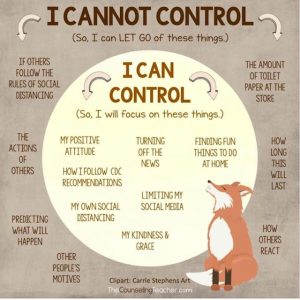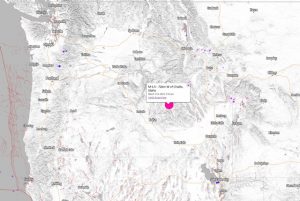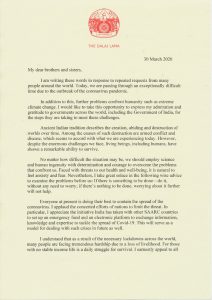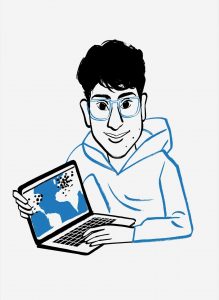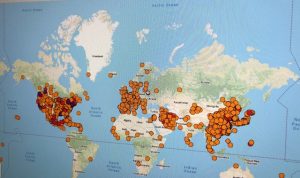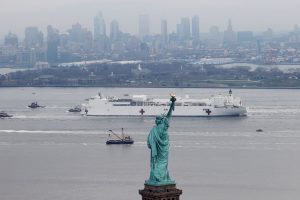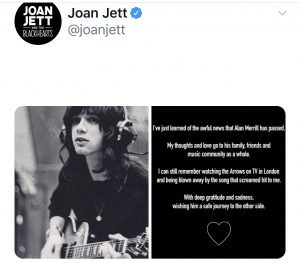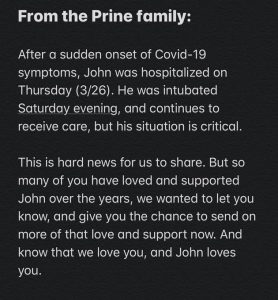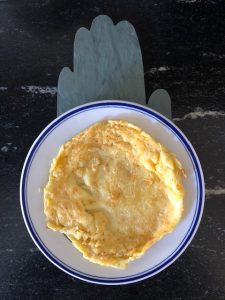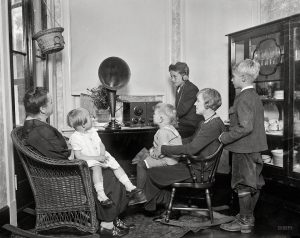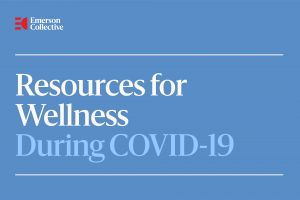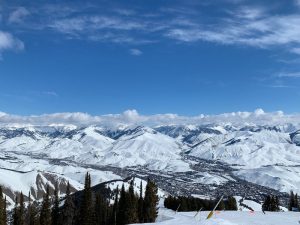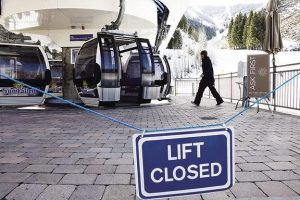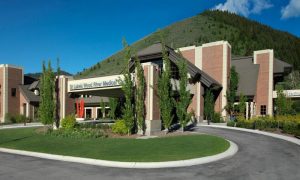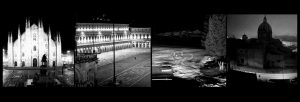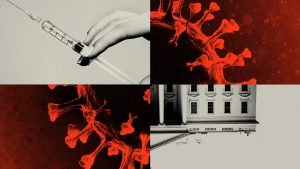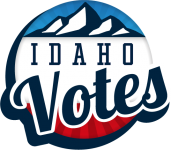The sweetness of noticing your life.
March 31, 2020I’m ready for some happiness. Mother Teresa reminds us.
Life is an opportunity, benefit from it.
Life is beauty, admire it.
Life is bliss, taste it.
Life is a dream, realize it.
Life is a challenge, meet it.
Life is a duty, complete it.
Life is a game, play it.
Life is a promise, fulfill it.
Life is sorrow, overcome it.
Life is a song, sing it.
Life is a struggle, accept it.
Life is a tragedy, confront it.
Life is an adventure, dare it.
Life is luck, make it.
Life is too precious, do not destroy it.
Life is life, fight for it.
The world, this shadow of the soul, or other me, lies wide around. Its attraction are the keys which unlock my thoughts and make me acquainted with myself. -Ralph Waldo Emerson
When do you feel you are most in touch with your spirit, the core of your being? Where are you? What are you doing? Who are you with? Who would you want to be with? How does this make you feel? -Alexandra Stoddard
If the future seems dark to us is it not perhaps because we are witnessing the dawn of a light that has never before been seen? We live in an age in which charity can become heroic as it has never been before. We live, perhaps, on the threshold of the greatest eucharistic era of the world–the earth that may witness the final union of all mankind. -Thomas Merton
Enjoyment is the sweetness of noticing your life right now; the sunset, the taste of cool water, the smell of clean sheets. Find something to enjoy right now. -Judith Hanson Lasater
“Do you know what those people are doing, boys? Fertilizing daffodils!” -Robin Williams as Mr. Keating in ‘Dead Poets Society’
Oh my gaia.
6.5 EARTHQUAKE FELT ACROSS IDAHO, CENTERED IN CHALLIS.
Felt in Montana, Washington, Oregon, Utah and Nevada.
It was intensely felt in Sun Valley, Idaho.
KTVB/NBC 7 Boise
6.5 magnitude earthquake rattles Idaho and 7 surrounding states
BOISE, Idaho — At 5:52 p.m. Tuesday, the Idaho and states throughout the Northwest were rattled by a 6.5 magnitude earthquake, according to the USGS.
The USGS reports that the epicenter was west of Challis and 73.3 miles north of Meridian.
According to the USGS map, the epicenter of the earthquake was next to Shake Creek and Laidlow Creek in the north-central Idaho mountains.
The USGS had a delay in reporting the earthquake because of social distancing, according to Paul Bodin, the head of the University of Washington seismology lab, who talked to our sister station in Seattle, KING.
KTVB staff felt the possible earthquake from North Boise, Meridian, and Nampa. One of our staff members said her family in Montana felt the earthquake.
People in seven different states reportedly felt the 6.5 magnitude earthquake, according to the USGS’s intensity map.
The earthquake came less than two weeks after a major quake rattled Utah, Idaho’s neighbor to the south. That 5.7-magnitude earthquake struck just outside Salt Lake City, damaging buildings and spurring evacuations.
Boise Mayor Lauren McLean tweeted out “Boise, yes you did feel an #earthquake. City officials are checking all our facilities and public safety officers are conducting structural checks downtown and in our neighborhoods.”
A 4.6-magnitude aftershock was felt after the earthquake throughout Boise and the Treasure Valley.
KTVB contacted several gas stations in Challis, Stanley, and Cascade and they said there was no severe damage to buildings or property there.
The Boise Police Department tweeted that they have not received any reports of damage.
The Custer County Sheriff’s Office told KTVB that they have no reported structural damage at this time.
This is a developing story and this article will be updated when further information is made available.
“You have to learn to deal with yourself.”
March 30, 2020
Solitary Confinement Advise for Life with Covid in the Free World
‘People have been asking me questions ever since this “shelter in place,” with people having to stay home. It’s somewhat similar I suppose to being in solitary confinement, even though you might be with family and whatnot.
Being in solitary confinement is really just being thrown upon yourself: You’re running around, just like people do in your regular life, and now all of a sudden you’re confronted with yourself, and find that in a lot of cases you haven’t really put anything into yourself to occupy yourself.
Everything is outward directed. That’s what happened to me 27 years ago, and what happens to a lot of guys who are initially thrown into this situation—it’s like being thrown into the ocean. You have to learn how to swim. You have to learn how to deal with yourself.
I’ve watched quite a few people fall apart, lose their minds. But I went in another direction. So 27 years later I’m still sound in mind and body and spirit. I attribute that to just reading and cultivating myself. That’s the thing, when you’re thrown upon yourself, you realize you are more equipped than you realized. A lot of the system keeps us from realizing our own power. It’s a good opportunity for people to tap into that.
Being in solitary confinement, it’s a punishment. But people out in society, it’s an opportunity for your kids to get more in tune with themselves. Because when you’re in school, especially with the internet being what it is, everybody is generally being pulled away from themselves.
The root word of education is “to educe,” to bring forth that which is already there. Education isn’t really about what kind of career you’re gonna get or how you’re gonna make money. That’s not why we were born, to make money for somebody else. To get a big house. To have a nice car. You’re here to bring forth that which is already there. Hopefully young people being forced to stay home outside of the mainstream curriculum are able to get a glimpse of themselves and start pulling on that thread.’
From His Holiness the Dalai Lama
My dear brothers and sisters,
I am writing these words in response to repeated requests from many people around the world. Today, we are passing through an exceptionally difficult time due to the outbreak of the coronavirus pandemic.
In addition to this, further problems confront humanity such as extreme climate change. I would like to take this opportunity to express my admiration and gratitude to governments across the world, including the Government of India, for the steps they are taking to meet these challenges.
Ancient Indian tradition describes the creation, abiding and destruction of worlds over time. Among the causes of such destruction are armed conflict and disease, which seems to accord with what we are experiencing today. However, despite the enormous challenges we face, living beings, including humans, have shown a remarkable ability to survive.
No matter how difficult the situation may be, we should employ science and human ingenuity with determination and courage to overcome the problems that confront us. Faced with threats to our health and well-being, it is natural to feel anxiety and fear. Nevertheless, I take great solace in the following wise advice to examine the problems before us: If there is something to be done—do it, without any need to worry; if there’s nothing to be done, worrying about it further will not help.
Everyone at present is doing their best to contain the spread of the coronavirus. I applaud the concerted efforts of nations to limit the threat. In particular, I appreciate the initiative India has taken with other SAARC countries to set up an emergency fund and an electronic platform to exchange information, knowledge and expertise to tackle the spread of Covid-19. This will serve as a model for dealing with such crises in future as well.
I understand that as a result of the necessary lockdowns across the world, many people are facing tremendous hardship due to a loss of livelihood. For those with no stable income life is a daily struggle for survival. I earnestly appeal to all concerned to do everything possible to care for the vulnerable members of our communities.
I offer special gratitude to the medical staff—doctors, nurses and other support personnel—who are working on the frontline to save lives at great personal risk. Their service is indeed compassion in action.
With heartfelt feelings of concern for my brothers and sisters around the world who are passing through these difficult times, I pray for an early end to this pandemic so that your peace and happiness may soon be restored.
With my prayers,
Dalai Lama
Local Journalism
‘Like many in business, trusted news organizations are being hit hard by this pandemic. If you can, please consider subscribing to your local paper or contributing to a VT news organization. You deserve transparency and the truth, and they work hard to keep you informed.
-Vermont Governor Phil Scott
NYTimes
Ben Smith
“Abandon most for-profit local newspapers, whose business model no longer works, and move as fast as possible to a national network of nimble new online newsrooms. That way, we can rescue the only thing worth saving… the journalists.”
Bail Out Journalists. Let Newspaper Chains Die.
The coronavirus is likely to hasten the end of advertising-driven media, our columnist writes. And government should not rescue it.
“There’s all this ‘doom and gloom for local journalism stories’ that have happened in the last week or so, and I hope that other people see what we’re doing and understand that the important thing is the journalism — it’s the stories, it’s the investigations — that’s what matters,” Ken Ward said. He will also be on the staff of the nonprofit investigative powerhouse ProPublica and will have support from Report for America, another growing nonprofit organization that sends young reporters to newsrooms around the country.
The news business, like every business, is looking for all the help it can get in this crisis. Analysts believe that the new federal aid package will help for a time and that the industry has a strong case to make. State governments have deemed journalism an essential service to spread public health information. Reporters employed by everyone from the worthiest nonprofit group to the most cynical hedge fund-owned chain are risking their lives to get their readers solid facts on the pandemic, and are holding the government accountable for its failures. Virtually every news outlet reports that readership is at an all-time high. We all need to know, urgently, about where and how the coronavirus is affecting our cities and towns and neighborhoods.
So what comes next? That decision will be made in the next few months — by public officials, philanthropists, and other tech companies, and people like you.
The right decision is to consistently look to the future, which comes in a few forms. The most promising right now is Ms. Green’s dream of a big new network of nonprofit news organizations across the country on the model o The Texas Tribune, which Mr. Thornton co-founded. There are also a handful of local for-profit news outlets, like The Seattle Times, The Los Angeles Times and The Boston Globe, with rich and civic-minded owners, and The Philadelphia Inquirer, which is owned by the non-profit Lenfest Institute for Journalism. And there is a generation of small, independent membership or subscription sites and newsletters like Berkeleyside.
Elizabeth Green, a founder of Chalkbeat, a nonprofit news organization reporting on education issues, in Washington, D.C.
[Avi Schiffmann]
The High Schooler Who Became a COVID-19 Watchdog
The New Yorker
by Brent Crane
In December, DT said, “We have a problem that, a month ago, nobody thought about.” Well, somebody did. On December 29th, as DT vacationed with his family at Mar-a-Lago, Avi Schiffmann, a seventeen-year-old from Washington State, launched a homemade Web site to track the movement of the coronavirus. Since then, the site, ncov2019.live, has had more than a hundred million visitors. “I wanted to just make the data easily accessible, but I never thought it would end up being this big,” the high-school junior said last week over FaceTime. Schiffmann, gap-toothed and bespectacled, was sitting on his bed wearing a blue T-shirt and baggy pajama bottoms. It was late morning. He was at his mother’s house, on Mercer Island, outside Seattle.
Using a coding tactic known as “web-scraping,” Schiffmann’s site collates data from different sources around the globe—the W.H.O., the C.D.C., Yonhap News Agency in South Korea—and displays the latest number of covid-19 cases. It features simple graphics and easy-to-read tables divided by nation, continent, and state. Data automatically updates every minute. In a politicized pandemic, where rumor and panic run amok, the site has become a reputable, if unlikely, watchdog.
He began teaching himself to code when he was seven, mainly by watching YouTube videos, and has made more than thirty Web sites. “Programming is a great creative medium,” he said. “Instead of using a paintbrush or something, you can just type a bunch of funky words and make a coronavirus site.” One of his first projects, in elementary school, was what he calls “a stick-figure animation hub.” Later sites collated the scores for his county’s high-school sports games, aggregated news of global protests, and displayed the weather forecast on Mars. “His brain is constantly going from one thing to another, which is good, but I also try to focus him in,” his mother, Nathalie Acher, said. “I’m not techy at all myself. I see it as just really boring. He sees it as an art form.”
Schiffmann took the virus threat seriously before many others did. “I’ve been kind of concerned for a while, because I watched it spread very fast, and around the entire world. I mean, it just kind of went everywhere.” He took his own precautions. “I got masks a while ago. I got, like, fifteen for seventeen dollars. Now you can’t even buy a single mask for, like, less than forty.” His mother chimed in. “I wish I had listened to him,” she said. “But, in his teen-ager way, he’d come down the stairs with his eyes huge and be, like, ‘There are fifty thousand more cases!’ and I’d be, like, ‘Yeah, but they’re over there, not here.’ ”
Her son is a C student.
Now that the grownups of the world are finally, and appropriately, freaking out, it is hard for Schiffmann not to feel righteous vindication. “If you told someone three months ago that we should spend, like, ten billion dollars in upgrading the United States’ health care, they would have been, like, ‘Nah,’ ” he said. “Now, everyone’s, like, ‘Oh, my God, yes.’ But this is the kind of stuff we should have done a long time ago.”
Young people give me so much hope. ❥ -dayle
Keeping Connected and Compassionate
The USNS Comfort hospital ship enters New York to help relieve the load on coronavirus-stricken hospitals.
NATURE.COM
Seven tips to manage your mental health and well-being during the COVID-19 outbreak
This is unlikely to be the writer’s retreat that you have long dreamt of. The suggestion that periods of quarantine might bring unprecedented productivity implies we should raise the bar, rather than lower it. Do not underestimate the cognitive and emotional load that this pandemic brings, or the impact it will have on your productivity, at least in the short term. Difficulty concentrating, low motivation and a state of distraction are to be expected. Adaptation will take time. Go easy on yourself. As we settle into this new rhythm of remote work and isolation, we need to be realistic in the goals we set, both for ourselves and others in our charge.
Proactively manage your stress threshold
Try to lay a solid foundation for your mental health and well-being by prioritizing your sleep, and practise good sleep hygiene (for example, avoid blue lights before bed, and maintain a routine around your sleep and wake times). Eat well (be conscious that you might be inclined to lean on alcohol, or other indulgences, to manage stress — this is understandable, but potentially damaging in the long run). Exercise: it will lower your stress levels, help you to better regulate your emotions and improve your sleep.
Know your red flags
One way to manage moments of distress is to identify key thoughts or physical sensations that tend to contribute to your cycle of distress and feelings of being overwhelmed. Our thoughts (“Why can’t I concentrate?”), feelings (frustration, worry, sadness), physical sensations (tension, upset stomach, jitters) and actions (such as compulsively checking the latest COVID statistics) each feed into and amplify these negative emotional spirals. Addressing one aspect of this loop by, for example, actively reducing the physical symptoms (I use box breathing: breathe in for four counts, hold for four, breathe out for four and hold for four, then repeat) can de-escalate the cycle and help you regain control.
Routine is your friend
It helps to manage anxiety, and will help you to adapt more quickly to this current reality. Create clear distinctions between work and non-work time, ideally in both your physical workspace and your head space. Find something to do that is not work and is not virus-related that brings you joy. Working in short bursts with clear breaks will help to maintain your clarity of thought.
Be compassionate with yourself and with others
There is much that we cannot control right now, but how we talk to ourselves during these challenging times can either provide a powerful buffer to these difficult circumstances or amplify our distress. Moments of feeling overwhelmed often come with big thoughts, such as “I cannot do this,” or “This is too hard.” This pandemic will cause a lot of stress for many of us, and we cannot be our best selves all the time. But we can ask for help or reach out when help is asked of us.
Maintain connections
Even the most introverted of us need some sense of connection to others for our mental as well as our physical health. Many working groups have created virtual forums where you can contribute or just sit back and enjoy the chatter. Staff teams have instigated virtual coffee groups, online book clubs and co-working spaces where you can work in the (virtual) presence of others. We are in social isolation, but we need not feel alone. Reach out to those who might be particularly isolated.
Manage uncertainty by staying in the present
Take each day as it comes and focus on the things you can control. Mindfulness and meditation can be great tools.
This will probably be a stressful time for all of us, and will test the mental-health policies and practices of many research institutes, just as it is testing much else in the world. By embracing good mental-health and well-being measures, and by relying on others when necessary, we can protect ourselves and those around us.
By clinical psychologist Desiree Dickerson
https://www.nature.com/articles/d41586-020-00933-5
‘Put another dime in the jukebox, baby.’
‘Alan Merrill, who wrote the song “I Love Rock and Roll” that became a signature hit for fellow rocker Joan Jett, died Sunday in New York of complications from the coronavirus, his daughter said. He was 69.’ #COVID19US
?
Egg Pancake
March 28, 2020Just learned about this from my quarantined friend in Italy; helps your egg supply go a little further.
(Apparently this was popular during the Great Depression.)
1 egg…whisk in some water…whisk in 1 tbs of flour until smooth…butter in a pan…cook like a pancake.
More filling, too.
Thanks, Jan.
♥
#GeneralStrike
The shift begins now.
Anand Giridharadas, political analyst and author, posted March 2020:
If we could come out of this crisis with a single widely shared belief, if some once-controversial idea could become a new consensus, what do you hope it would be?
Here’s mine:
COVID has revealed the U.S. Government is more harmful than helpful. We the people are the power. We can see the shift now. When the people stop, everything stops. And the billionaires panic. We choose. #GeneralStrike
RBG
-Tony Dokoupil, CBS This Morning co-host
In 2009, I interviewed Ruth Bader Ginsburg about the “upsides” of the Great Depression, which got me mocked on Gawker. (Deserved it.) It was part of a series with people who lived through the Depression and it got burned off the web in the many fires of Newsweek’s demise.But I found the original text in an old email this morning and as we confront another hard time, I thought this passage from Justice Ginsburg was especially worth bearing in mind:
“I can’t say that I knew about the breadlines. But as an adult I found it hard to understand why a country with our resources had such great discrepancies between the rich and poor. Fortunately, there has been significant change in that regard…
“Today we would never allow what happened during the Depression to happen again—we would never just leave people totally without resources…”
“We have the Depression to thank for that. It helped the country accept what our European allies had long understood: that the poor were the responsibility of the whole community…
“Social security, unemployment benefits, FDIC-such programs never would have passed without the Depression. They would have been called Socialist. So, yes, I think the Depression left the country better off.”
Imagine that.
Emerson Collective
Dear Partners,
This moment is testing all of us—our teams, families, and communities—in new ways. And we wanted to share some wellness resources in case they are helpful in the days and weeks ahead.
Below are tools for crisis support and intervention, managing anxiety, mindfulness and movement, ways to share art and stories, support for children and teens, and resources in Spanish.
We hope they are useful, and we will continue to look for ways to support one another during this challenging time.
The Emerson Collective Team
Crisis Support and Intervention
Crisis Text Line
Text SHARE to 741741 to reach a crisis counselor, 24/7, for free, confidential support.
Crisis Text Line counselors are available to connect about anxiety related to the novel coronavirus, isolation, students’ concerns about school, financial stress, and other concerns.
Managing Anxiety
Managing Anxiety and Stress Related to the Coronavirus
Centers for Disease Control and Prevention (CDC)
Tips on stress and coping, with specialized advice for parents, responders, and people who have been released from quarantine.
Avoiding Misinformation on COVID-19
News Literacy Project
How to spot—and avoid spreading—misinformation, and identify reliable sources of information.
Mindfulness and Movement
Meditations for Focus, Stress, Sleep—and Even Handwashing
Headspace
The Headspace app is offering a free set of meditation, sleep, and movement exercises, “Weathering the Storm,” specific to this time; a free suite of tools and guided meditations for business and employees, and free Headspace Plus accounts for providers who work in public health settings.
Dance Classes At Home
ODC
Join ODC’s teachers and community online while the physical studio doors are closed. Sign up for a live-streamed class or follow along with a Fusion Light class from Rhythm & Motion.
Exercising during a Pandemic
The Atlantic
Expert advice on getting exercise at home or while maintaining social distancing.
Sharing Art and Stories, Spreading Joy
A Daily Story to Lift Your Spirits
StoryCorps
StoryCorps is putting some of the most heartwarming stories from their collection in a daily newsletter. Sign up for reminders of heart, humanity, and generosity from everyday people.
Virtual Museum Visits
Google Arts & Culture
Key pieces from the collections of 2,500 museums worldwide, including special online exhibits.
Supporting Children and Teenagers
For many excellent resources for supporting school-age children while their schools are closed, please see Resources for Remote Learning.
Talking to Kids about the Coronavirus
Child Mind Institute
Guidance for parents of young and school-age children on talking to them about coronavirus.
Teens Facing a New Normal
UNICEF
Strategies for teens to protect their mental health while facing a (temporary) new normal.
Recursos en Español
Maneje la Ansiedad y el Estrés
Centros para el control y la prevención de enfermedades (CDC)
Consejos sobre estrés y afrontamiento, con consejos especializados para padres, personal de auxilio y personas que han sido liberadas de la cuarentena.
Cómo Hablar con los Niños sobre el Coronavirus
Child Mind Institute
Guía para padres de niños pequeños y en edad escolar sobre cómo hablarles sobre el coronavirus.
Volunteer to Support Others
And if you’re looking for a way to serve others—during this difficult time, and beyond it—consider training as a crisis counselor for Crisis Text Line. The training can be done from home, and teaches the skills of reflective listening, collaborative problem solving, and crisis management.
We will continue to update this list of resources. Feel free to share this with your loved ones, friends, and networks as we all navigate this difficult time together.
Please, stay away.
Sun Valley, Idaho: ‘No One Should Come Here’
NPR/Kirk Siegler
Blaine County, Idaho, which includes the resort town of Sun Valley, has one of the highest known rates of COVID-19 cases in the West.
‘To hear year-round Sun Valley, Idaho, residents like Justin Malloy tell it, town right now is as crowded as you’d expect to see it in the peak Fourth of July or Christmas seasons. The small airport is packed with private jets. And then there’s the parking lot at the Atkinsons’ Supermarket, one of only two in town where bread and essential cleaning items are particularly hard to come by.
“We’ve been seeing a lot of Washington plates, a lot of California plates, their cars just full of all of their stuff that they’ve brought from out of state,” Malloy says.
This has fueled outrage on social media, and on unusually crowded hiking and ski trails, where locals are wondering aloud whether rich people are fleeing cities to seek refuge in rural Idaho, and unknowingly making the public health crisis here even worse.
“It seems likely that people were fleeing other places and not recognizing that they were then bringing the disease with them from Seattle, or other areas where they might live part time,” says Dr. Josh Kern, vice president of medical affairs for St. Luke’s Wood River Medical Center in Ketchum.
While resort towns like this can typically house a lot of tourists or second- and third-home owners, that doesn’t extend to St. Luke’s, which has only 25 beds. The hospital has had dozens of COVID-related admissions and officials warn there are likely many more cases in the community than what’s been diagnosed.
That’s leading to some impassioned pleas to take the recent, strict self-isolation orders seriously.
“No one should come here,” says Dr. Brent Russell, a local emergency room physician.
Russell should know. He has COVID-19. He’s been very sick, so can’t work at this critical time.
“We have a really high percent of COVID spreading among the population here,” Russell says. “If you come here, that is putting your life at risk and it’s putting other lives at risk.”
The hospital is part of a regional health care system, St. Luke’s, so for now, support has been coming from hospitals in Twin Falls and Boise where there aren’t as many known cases. Yet.
https://www.npr.org/2020/03/27/822122059/sun-valley-idaho-no-one-should-come-here
Blaine County COVID rates rival NYC, Wuhan
News analysis: Comparisons are difficult, but the valley has one of the nation’s highest concentration of coronavirus cases
Idaho Mountain Express/Mark Dee
The raw numbers may pale compared to major cities, but Blaine County had the nation’s highest concentration of lab-confirmed COVID-19 cases in the nation yesterday, according to data compiled by the New York Times.
And, its calculation is an underestimate.
So, what do you do with that information? “Take this seriously,” according to a group of eight St. Luke’s Wood River emergency physicians. Self-isolate and abide by the shelter-in-place order designed to stem the spread of the disease.
“We want you to know, given the community spread, that you should not wait for the test or test result,” Drs. Terry O’Connor, Malie Kopplin, Deb Robertson, Jim Torres, Brock Bemis, Keith Sivertson, Terry Ahern and Brent Russell wrote in a letter to the Idaho Mountain Express published Wednesday. “There are measures you can take now to protect yourself, your family, friends, neighbors and way of life. Self-isolate. Don’t leave the Wood River Valley to recreate elsewhere. It’s well known that we have a very high rate of infection; 5B plates are not going to be welcomed outside of Blaine County. Moab and Twin Falls don’t need our virus. Stay home. Save lives.”
Blaine County Deals With Coronavirus Hot Spot As Other Rural Idaho Communities Prepare For the Worst
Boise State Public Radio/Rachel Cohen
St. Luke’s Wood River Medical Center suspended normal operations last week. Coronavirus screening sites, a walk-in-clinic and the emergency department remain open.
If a patient needed to be hospitalized for symptoms of coronavirus in the Wood River Valley today, they’d most likely be transported — by ambulance or helicopter — to a hospital in Twin Falls an hour and a half south, or one in Boise two and a half hours west.
Blaine County — home to Sun Valley, with a population of about 22,000 — is the epicenter of Idaho’s coronavirus outbreak.
“So currently any patient who would be that sick would not be maintained up here. We would be transferring them either down to Magic Valley or Boise,” said Dr. Frank Batcha, a family physician at the St. Luke’s clinic in nearby Hailey.
Patients seeking care for routine check-ups, cancer screenings or caesarean sections are also being directed to other hospitals.
“Are we concerned about not having enough resources? Absolutely. And that’s why we’re trying to conserve what we have right now, particularly our manpower,” said Batcha, who, these days, is typically clad head to toe in personal protective gear as he screens patients for COVID-19 in the parking lot of the Ketchum hospital.
St. Luke’s Wood River is part of the statewide St. Luke’s Health System with seven hospitals, which means staff and supplies can, and are, being dedicated to the Ketchum hospital.
“If we were an isolated, rural hospital, we would be crippled right now, because we have so many people who are out with the illness,” Russell told Boise State Public Radio’s George Prentice.
But strains extend beyond the hospital. Bill McLaughlin, the Ketchum Fire Chief who also oversees EMS services for the north half of the valley, said around a quarter of his paramedics are out because they have coronavirus symptoms or have potentially been exposed in the community.
“We only have a couple paramedics on each day, and if, for some reason, one of them gets sick, then that entire shift would be knocked out for 14 days,” McLaughlin said.
Many volunteers who used to help out are staying home, too.
[full article]
So good.
#ComicRelief
Lift Your Spirits
‘We’re all in this together. So, we’re putting some of the most heartwarming stories from our collection in a daily newsletter to help keep your spirits boosted and your faith in humanity strong. Sign up for reminders of heart, humanity, and generosity’
16:56
wowwowwow
First new music in eight years.
Brilliant.
What’d I say? / I said the soul of a nation been torn away / And it’s beginning to go into a slow decay / And that it’s 36 hours past Judgment Day.
‘Greetings to my fans and followers with gratitude for all your support and loyalty across the years. This is an unreleased song we recorded a while back that you might find interesting. Stay safe, stay observant and may God be with you.’– Bob Dylan
Endarkment
March 27, 2020“One does not become enlightened by imagining figures of light,” Carl Jung wrote, “but by making the darkness conscious.” Reading this, I realize that in a whole lifetime spent with seekers of enlightenment, I have never once heard anyone speak in hushed tones about the value of endarkenment. -Barbara Taylor Brown, author & Episcopal priest
And so even now, as light gives way to darkness, I know that once again light is born from darkness. Those who read out to help strangers are living out the oneness that is part of our spiritual DNA. -Science of Mind
What are we only now coming “to know” through this time of not-knowing?
Either we will love and help one another or we will hate and attack one another, in which latter case we will all be one another’s hell. Perhaps Sartre was not far wrong in saying that where freedom is abused, society itself turns into heel.. (L’enfer c’est les autres.”) -Thomas Merton
Yuval Noah Harari: the world after coronavirus
This storm will pass. But the choices we make now could change our lives for years to come.
Humankind is now facing a global crisis. Perhaps the biggest crisis of our generation. The decisions people and governments take in the next few weeks will probably shape the world for years to come. They will shape not just our healthcare systems but also our economy, politics and culture. We must act quickly and decisively. We should also take into account the long-term consequences of our actions. When choosing between alternatives, we should ask ourselves not only how to overcome the immediate threat, but also what kind of world we will inhabit once the storm passes. Yes, the storm will pass, humankind will survive, most of us will still be alive — but we will inhabit a different world.
Many short-term emergency measures will become a fixture of life. That is the nature of emergencies. They fast-forward historical processes. Decisions that in normal times could take years of deliberation are passed in a matter of hours. Immature and even dangerous technologies are pressed into service, because the risks of doing nothing are bigger. Entire countries serve as guinea-pigs in large-scale social experiments. What happens when everybody works from home and communicates only at a distance? What happens when entire schools and universities go online? In normal times, governments, businesses and educational boards would never agree to conduct such experiments. But these aren’t normal times.
The coronavirus epidemic is thus a major test of citizenship. In the days ahead, each one of us should choose to trust scientific data and healthcare experts over unfounded conspiracy theories and self-serving politicians. If we fail to make the right choice, we might find ourselves signing away our most precious freedoms, thinking that this is the only way to safeguard our health.
[full read]
https://www.ft.com/content/19d90308-6858-11ea-a3c9-1fe6fedcca75
How the Pandemic Will End
The U.S. may end up with the worst COVID-19 outbreak in the industrialized world. This is how it’s going to play out.
Story by Ed Yong
The testing fiasco was the original sin of America’s pandemic failure, the single flaw that undermined every other countermeasure. If the country could have accurately tracked the spread of the virus, hospitals could have executed their pandemic plans, girding themselves by allocating treatment rooms, ordering extra supplies, tagging in personnel, or assigning specific facilities to deal with COVID-19 cases. None of that happened. Instead, a health-care system that already runs close to full capacity, and that was already challenged by a severe flu season, was suddenly faced with a virus that had been left to spread, untracked, through communities around the country. Overstretched hospitals became overwhelmed. Basic protective equipment, such as masks, gowns, and gloves, began to run out. Beds will soon follow, as will the ventilators that provide oxygen to patients whose lungs are besieged by the virus.
The White House is a ghost town of scientific expertise. A pandemic-preparedness office that was part of the National Security Council was dissolved in 2018. On January 28, Luciana Borio, who was part of that team, urged the government to “act now to prevent an American epidemic,” and specifically to work with the private sector to develop fast, easy diagnostic tests. But with the office shuttered, those warnings were published in The Wall Street Journal, rather than spoken into the president’s ear. Instead of springing into action, America sat idle.
After 9/11, the world focused on counterterrorism. After COVID-19, attention may shift to public health. Expect to see a spike in funding for virology and vaccinology, a surge in students applying to public-health programs, and more domestic production of medical supplies. Expect pandemics to top the agenda at the United Nations General Assembly. Anthony Fauci is now a household name. “Regular people who think easily about what a policewoman or firefighter does finally get what an epidemiologist does,” says Monica Schoch-Spana, a medical anthropologist at the Johns Hopkins Center for Health Security.
The lessons that America draws from this experience are hard to predict, especially at a time when online algorithms and partisan broadcasters only serve news that aligns with their audience’s preconceptions. Such dynamics will be pivotal in the coming months, says Ilan Goldenberg, a foreign-policy expert at the Center for a New American Security. “The transitions after World War II or 9/11 were not about a bunch of new ideas,” he says. “The ideas are out there, but the debates will be more acute over the next few months because of the fluidity of the moment and willingness of the American public to accept big, massive changes.”
[full read]
https://www.theatlantic.com/health/archive/2020/03/how-will-coronavirus-end/608719/
7 Resources for Reliable Information About Coronavirus
1. The World Health Organization
The World Health Organization (WHO) is publishing rolling updates on the coronavirus situation as well as useful infographics and explainers, and should be your first port of call for new assessments of what is going on.
The WHO has also got a really handy page on common coronavirus myths — covering everything from whether eating garlic or taking a bath can help prevent you catching it (they can’t), to discussion about what age people are most susceptible.
2. The National Health Service
The UK’s NHS is another excellent resource. It includes easy to understand advice about symptoms, and what to do if you think you have them.
It also gives details of how and under which circumstances you need to self-isolate, and for how long, and on how to get a self-isolation medical advice note to get to your employer.
3. The BBC Coronavirus Podcast
The British Broadcasting Corporation (BBC) has launched a Coronavirus Global Update podcast, which includes a daily round-up on the spread of coronavirus.
It also includes reports from affected areas, details of the latest medical information, and the impact on health, business, and travel.
4. COVID-19 Facts
The COVID-19 Facts website works to collate information from sources including the London School of Hygiene and Tropical Medicine, the World Health Organization, and the Economist Intelligence Unit.
It also features a series covering myths around coronavirus, including analysis by the Economist Intelligence Unit of where the myth came from, and what experts say about it.
5. The New Scientist Podcast
The New Scientist podcast is becoming increasingly focused on COVID-19 — including episodes and pandemic preparations; the spread of COVID-19 and the importance of hand washing; the coronavirus vaccine; and a coronavirus special on disaster preparation and environmental change.
6. The Bill & Melinda Gates Foundation
The content platform of the Bill & Melinda Gates Foundation, the Optimist, is sharing stories, research, and news stories about coronavirus from the Foundation.
The platform works to convene expert voices from across the global health sector, including sharing expert perspectives and updates on the response to COVID-19 — and you can also sign up for the Optimist’s news digest.
7. The London School of Hygiene and Tropical Medicine
The LSHTM launched its new podcastLSHTM Viral in January 2020, in response to the outbreak of COVID-19, and is releasing a new episode every week. It specifically focuses on the science behind outbreaks and how we respond to them.
Meanwhile, the LSHTM is also launching an online short course, for those who want to better understand the emergence of COVID-19, and how we respond to it moving forward.
The free-of-charge course launches on March 23, and will cover topics like: how COVID-19 emerged and was identified; public health measures worldwide; and what’s needed to address COVID-19 in the future.
Given that everything is going to be the way it’s going to be, we’re left with an actually useful and productive question instead: “What are you going to do about it?”
-Seth Godin
Anticipatory grief.
Stocking up on compassion.
Name it.
That Discomfort You’re Feeling Is Grief
Harvard Business Review
Anticipatory grief is the mind going to the future and imagining the worst. To calm yourself, you want to come into the present.
Finally, it’s a good time to stock up on compassion. Everyone will have different levels of fear and grief and it manifests in different ways. A coworker got very snippy with me the other day and I thought, That’s not like this person; that’s how they’re dealing with this. I’m seeing their fear and anxiety. So be patient. Think about who someone usually is and not who they seem to be in this moment.
When you name it, you feel it and it moves through you. Emotions need motion. It’s important we acknowledge what we go through.
It’s absurd to think we shouldn’t feel grief right now. Let yourself feel the grief and keep going.
https://hbr.org/2020/03/that-discomfort-youre-feeling-is-grief
The other side of the virus.
March 24, 2020A poem from a Jesuit priest.
The Other Side of the Virus,
An Opportunity to Awaken…
Yes there is panic buying.
Yes there is sickness.
Yes there is even death.But,
They say that in Wuhan after so many years of noise
You can hear the birds again.They say that after just a few weeks of quiet
The sky is no longer thick with fumes
But blue and grey and clear.They say that in the streets of Assisi
People are singing to each other
across the empty squares,
keeping their windows open
so that those who are alone
may hear the sounds of family around them.They say that a hotel in the West of Ireland
is offering free meals and delivery to the housebound.Today a young woman I know
is busy spreading fliers with her number
through the neighbourhood
so that the elders may have someone to call on.Today Churches, Synagogues, Mosques and Temples
are preparing to welcome
and shelter the homeless, the sick, the weary.All over the world people are slowing down and reflecting.
All over the world people are looking at their neighbours in a new way.
All over the world people are waking up to a new reality
To how big we really are.
To how little control we really have.
To what really matters.
To Love.So we pray and we remember that
Yes there is fear.
But there does not have to be hate.Yes there is isolation.
But there does not have to be loneliness.Yes there is panic buying.
But there does not have to be meanness.Yes there is sickness.
But there does not have to be disease of the soulYes there is even death.
But there can always be a rebirth of love.Wake to the choices you make as to how to live now.
Today, breathe.
Listen, behind the factory noises of your panic-
The birds are singing again
The sky is clearing,
Spring is coming,And we are always encompassed by Love.
Open the windows of your soul
And though you may not be able
to touch across the empty square,Sing.
– Written by Fr. Richard Hendrick
#Census2020
‘April 1st is an important date for the census. It’s the date you should use as a reference when completing the census — that means filling out information for anyone who lives in your household as of that date.
It’s important to make sure your household is counted! The data from your community is used to determine how many congressional districts your state will have for the next decade. With 435 representatives across the country, states could gain or lose a district based on population changes.’
Get counted! Fill out the 2020 Census here: https://my2020census.gov
Pandemic vote.
As our country continues to be ravaged by COVID-19, states and political leaders are trying to secure the safety of our elections. In Idaho, we can now request an absentee ballot for the state primary for May 19th. COVID-19 is changing daily, hourly. Confirmed cases grows exponentially. Social distancing and increased infections could compromise our voting locations.

